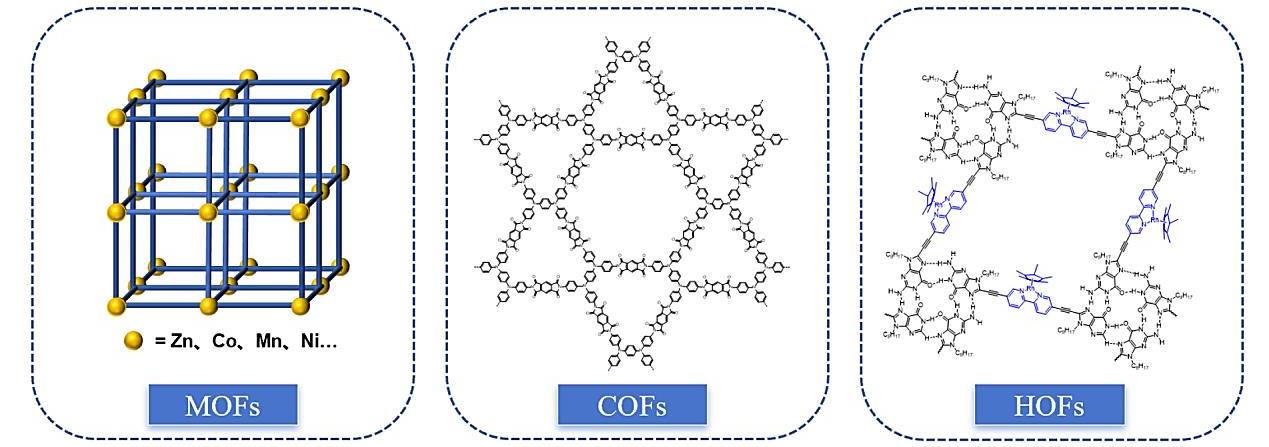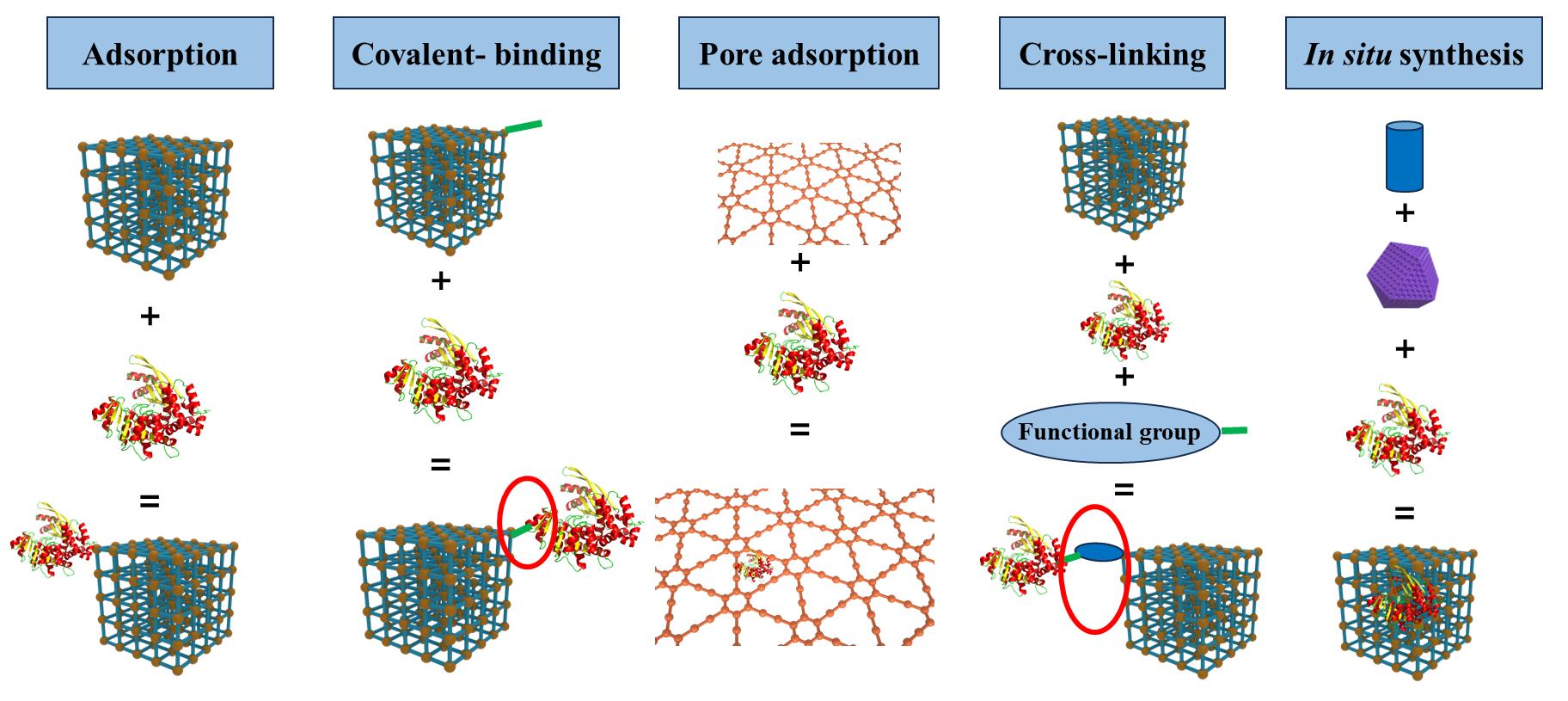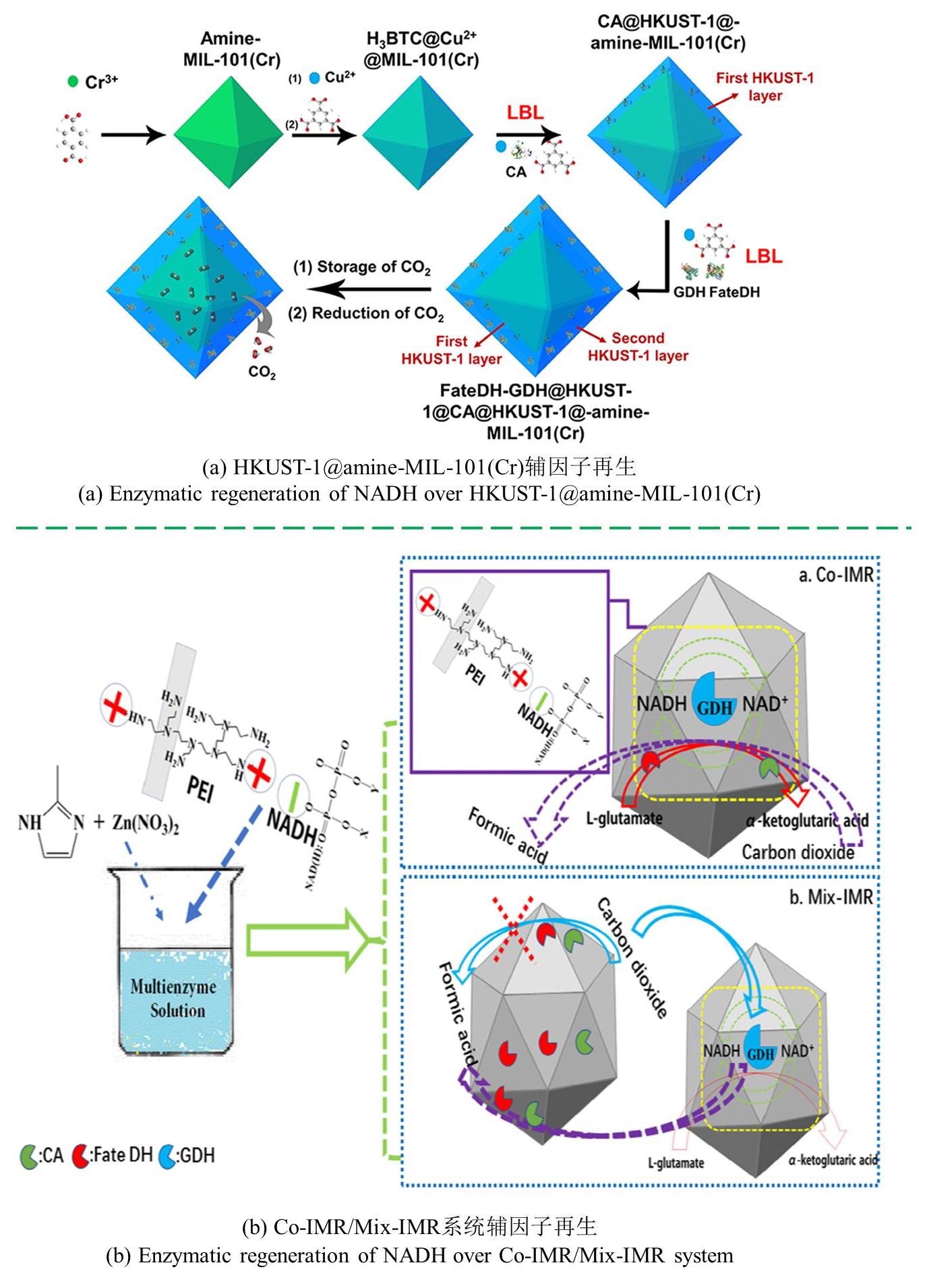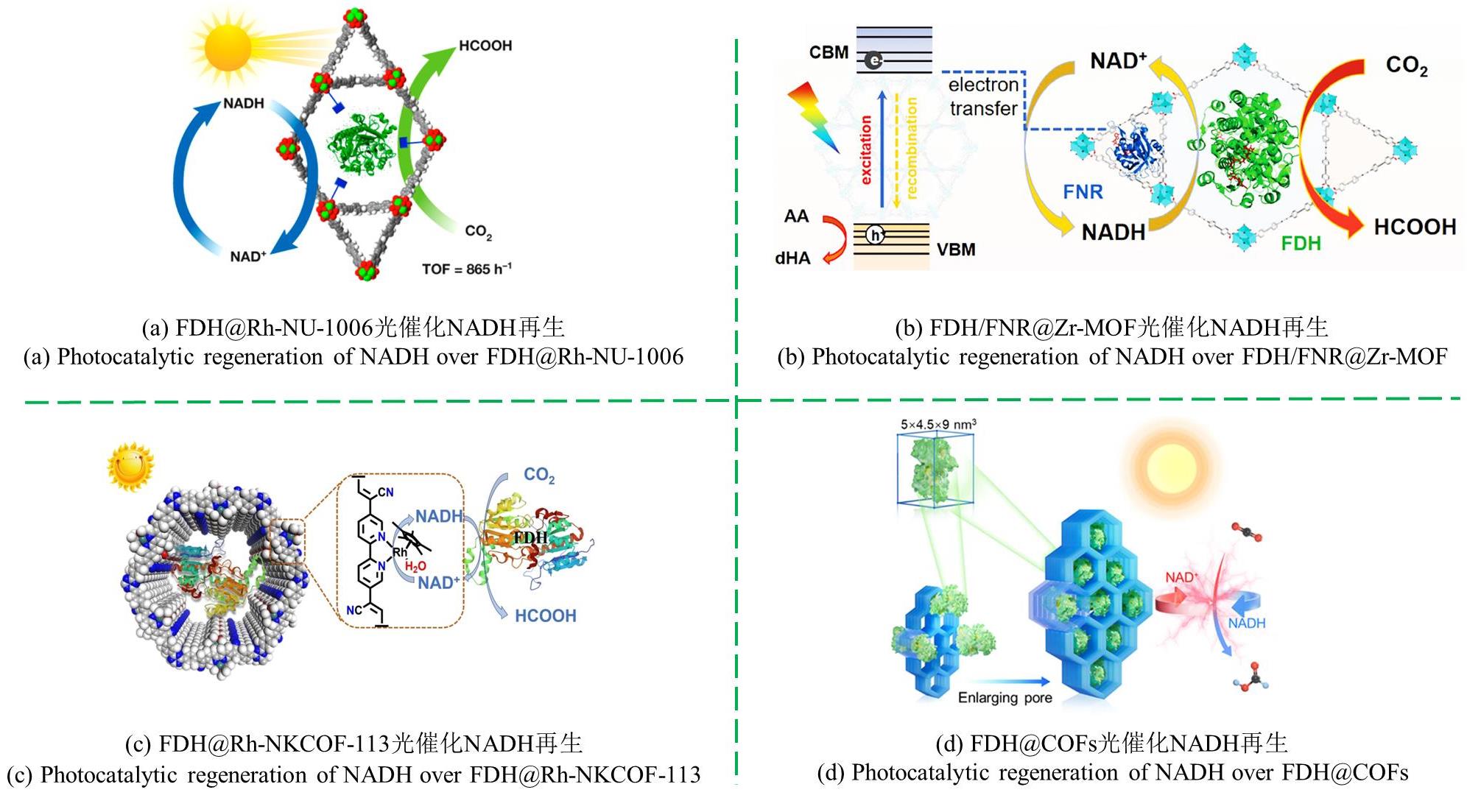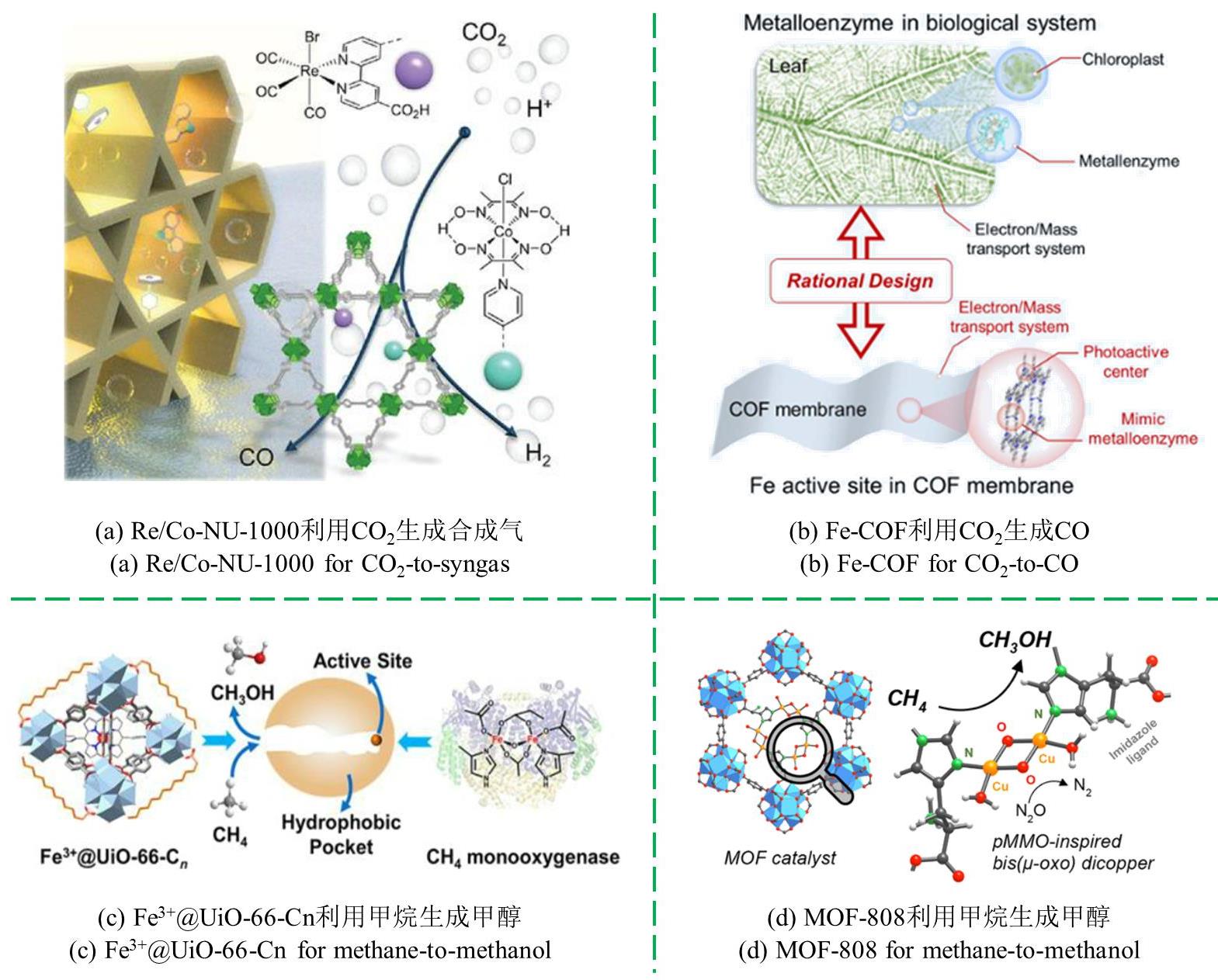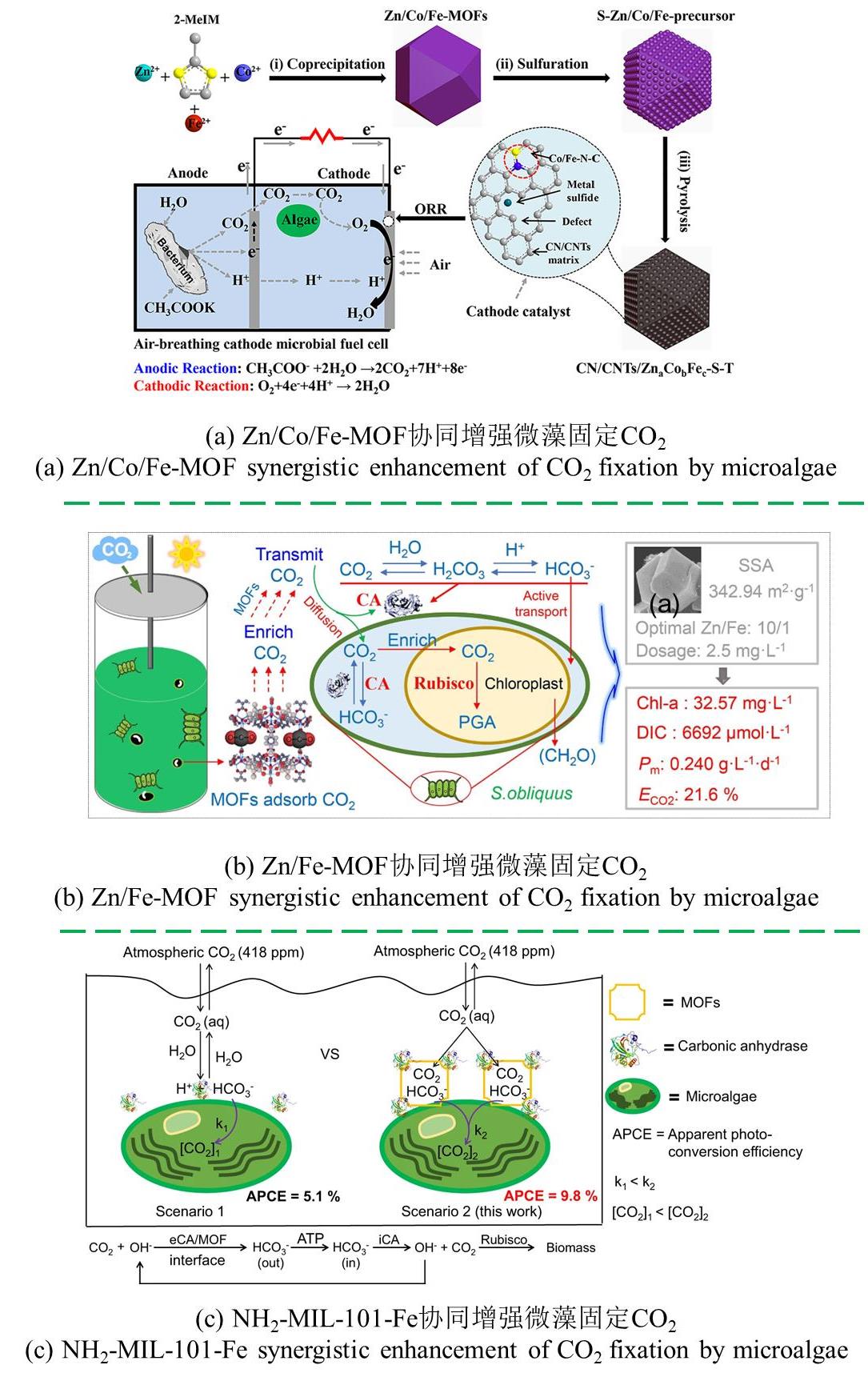Application of functional framework materials in C1 biotransformation
Zeyan DI1,2, Shuo ZHOU1,2, Mingfang YANG1,2, Xin LIU1, Yao CHEN1,2
- 1.State Key Laboratory of Biopharmaceutical Preparation and Delivery,Institute of Process Engineering,Chinese Academy of Sciences,Beijing 100190,China
2.State Key Laboratory of Medicinal Chemical Biology,Nankai University,Tianjin 300071,China
-
Received:2025-01-02Revised:2025-03-09Published:2025-03-11 -
Contact:Xin LIU, Yao CHEN
功能框架材料在一碳生物转化中的应用
狄泽燕1,2, 周铄1,2, 杨铭方1,2, 刘昕1, 陈瑶1,2
- 1.中国科学院过程工程研究所,生物药制备与递送全国重点实验室,北京 100190
2.南开大学,药物化学生物全国重点实验室,天津 300071
-
通讯作者:刘昕,陈瑶 -
作者简介:狄泽燕 (1999—),女,在读硕士。研究方向为晶态材料固定化酶。E-mail:dizeyan@163.com刘昕 (1992—),女,博士,助理研究员。研究方向为合成生物学以及光-生物偶联催化。E-mail:liuxin@ipe.ac.cn陈瑶 (1984—),女,博士,教授。研究方向为生物大分子/细胞固定化制剂、新型生物医药材料及相关应用转化(如生物药制剂及生物催化等)。E-mail:chenyao@ipe.ac.cn -
基金资助:国家重点研发计划(2021YFC2102100);国家自然科学基金面上项目(22371136);生物药制备与递送全国重点实验室自主部署课题(552024000621);中科院“百人计划”(2024ZZ-03)
CLC Number:
Cite this article
Zeyan DI, Shuo ZHOU, Mingfang YANG, Xin LIU, Yao CHEN. Application of functional framework materials in C1 biotransformation[J]. Synthetic Biology Journal, DOI: 10.12211/2096-8280.2025-003.
狄泽燕, 周铄, 杨铭方, 刘昕, 陈瑶. 功能框架材料在一碳生物转化中的应用[J]. 合成生物学, DOI: 10.12211/2096-8280.2025-003.
share this article
Add to citation manager EndNote|Ris|BibTeX
URL: https://synbioj.cip.com.cn/EN/10.12211/2096-8280.2025-003
| 酶 | 催化反应 | 参考文献 |
|---|---|---|
| 甲酸脱氢酶 | [ | |
| 碳酸酸酐酶 | [ | |
| 重塑固氮酶 | [ | |
| 一氧化碳脱氢酶 | [ | |
| 多重脱氢酶 | [ | |
| 丙酮酸脱酸酶 | [ |
Tab. 1 Common enzymes for C1 conversion
| 酶 | 催化反应 | 参考文献 |
|---|---|---|
| 甲酸脱氢酶 | [ | |
| 碳酸酸酐酶 | [ | |
| 重塑固氮酶 | [ | |
| 一氧化碳脱氢酶 | [ | |
| 多重脱氢酶 | [ | |
| 丙酮酸脱酸酶 | [ |
| 1 | Liu K, Bigdeli F, Panjehpour A, et al. Metal organic framework composites for reduction of CO2 [J]. Coordination Chemistry Reviews, 2023,493:215257. |
| 2 | Li D, Kassymova M, Cai X, et al. Photocatalytic CO2 reduction over metal-organic framework-based materials[J]. Coordination Chemistry Reviews, 2020,412:213262. |
| 3 | 史硕博, 王禹博, 乔玮博, 等. 第三代生物炼制的挑战与机遇[J]. 科学通报, 2023,68(19):2489-2503. |
| Shi S, Wang Y, Qiao W, et al. Challenges and opportunities in the third-generation biorefinery[J]. Chinese Science Bulletin, 2023,68(19):2489-2503. | |
| 4 | Wang K, Su C, Bi H, et al. The transition from 2g to 3g-feedstocks enabled efficient production of fuels and chemicals[J]. Green Energy & Environment, 2024,9(11):1759-1770. |
| 5 | Lv X, Yu W, Zhang C, et al. C1-based biomanufacturing: advances, challenges and perspectives[J]. Bioresource Technology, 2023,367:128259. |
| 6 | Qiao Y, Ma W, Zhang S, et al. Artificial multi-enzyme cascades and whole-cell transformation for bioconversion of C1 compounds: advances, challenge and perspectives[J]. Synthetic and Systems Biotechnology, 2023,8(4):578-583. |
| 7 | 叶伟, 李芮, 姜卫红, 等. 二氧化碳微生物转化与体外酶催化体系研究进展[J]. 合成生物学, 2023,4(6):1223-1245. |
| Wei Y E, Rui L I, Weihong J, et al. Microbial conversion and in vitro enzymatic catalysis for carbon dioxide utilization:a review[J]. Synthetic Biology Journal, 2023,4(6):1223-1245. | |
| 8 | 刘洁铮, 刘敏, 赵广, 等. 一碳化合物非天然生物转化的研究进展[J]. 激光生物学报, 2024,33(5):385-399. |
| Jiezheng L, Min L, Guang Z, et al. Progress in Artificial Microbiol Transformation of One-carbon Compounds[J]. Acta Laser Biology Sinica, 2024,33(5):385-399. | |
| 9 | Wang K, Zhang J, Hsu Y, et al. Bioinspired framework catalysts: from enzyme immobilization to biomimetic catalysis[J]. Chemical Reviews, 2023,123(9):5347-5420. |
| 10 | Chen L, Luque R, Li Y. Controllable design of tunable nanostructures inside metal-organic frameworks[J]. Chemical Society Reviews, 2017,46(15):4614-4630. |
| 11 | Mu C, Xu F, Lei W. Application of functional metal-organic framework materials[J]. Progress in Chemistry, 2007,19(9):1345-1356. |
| 12 | Zhou H, Long J R, Yaghi O M. Introduction to metal-organic frameworks[J]. Chemical Reviews, 2012,112(2):673-674. |
| 13 | Zhou H C, Kitagawa S. Metal-organic frameworks (MOFs)[J]. Chemical Society Reviews, 2014,43(16):5415-5418. |
| 14 | Cravillon J, Münzer S, Lohmeier S, et al. Rapid room-temperature synthesis and characterization of nanocrystals of a prototypical zeolitic imidazolate framework[J]. Chemistry of Materials, 2009,21(8):1410-1412. |
| 15 | Zhang R, Xie Y, Yu C, et al. Research progress of design,synthesis and application of MOFs catalyst[J]. New Chemical Materials, 2021,49(1):223-228. |
| 16 | Xiao K, Shu B, Lv K, et al. Recent progress of MIL MOF materials in degradation of organic pollutants by fenton reaction[J]. Catalysts, 2023,13(4):734. |
| 17 | Horcajada P, Chalati T, Serre C, et al. Porous metal-organic-framework nanoscale carriers as a potential platform for drug delivery and imaging[J]. Nature Materials, 2010,9(2):172-178. |
| 18 | Wang D, Yao H, Ye J, et al. Metal‐organic frameworks (MOFs): classification, synthesis, modification, and biomedical applications[J]. Small, 2024,20(47):e2404350. |
| 19 | Kouser S, Hezam A, Khadri M J N, et al. A review on zeolite imidazole frameworks: synthesis, properties, and applications[J]. Journal of Porous Materials, 2022,29(3):663-681. |
| 20 | Yang X G, Zhang J R, Tian X K, et al. Enhanced activity of enzyme immobilized on hydrophobic ZIF‐8 modified by Ni2+ ions[J]. Angewandte Chemie International Edition, 2023,62(7):e202216699. |
| 21 | 王茀学, 王崇臣, 王鹏, 等. UiO系列金属-有机骨架的合成方法与应用[J]. 无机化学学报, 2017,33(5):713-737. |
| Wang F X, Wang C C, Wang P, et al. Syntheses and Applications of UiO Series of MOFs[J]. Chinese Journal of Inorganic Chemistry, 2017,33(5):713-737. | |
| 22 | Zhou J, Gu S, Xiang Y, et al. UiO-67: a versatile metal-organic framework for diverse applications[J]. Coordination Chemistry Reviews, 2025,526:216354. |
| 23 | Beuerle F, Gole B. Covalent organic frameworks and cage compounds: design and applications of polymeric and discrete organic scaffolds[J]. Angewandte Chemie International Edition, 2018,57(18):4850-4878. |
| 24 | Tran Q N, Lee H J, Tran N. Covalent organic frameworks: from structures to applications[J]. Polymers, 2023,15(5):1279. |
| 25 | El-Kaderi H M, Hunt J R, Mendoza-Cortés J L, et al. Designed synthesis of 3d covalent organic frameworks[J]. Science, 2007,316(5822):268-272. |
| 26 | Côté A P, Benin A I, Ockwig N W, et al. Porous, crystalline, covalent organic frameworks[J]. Science, 2005,310(5751):1166-1170. |
| 27 | Khan M M, Rahman A, Matussin S N. Recent progress of metal-organic frameworks and metal-organic frameworks-based heterostructures as photocatalysts[J]. Nanomaterials, 2022,12(16):2820. |
| 28 | Hisaki I, Xin C, Takahashi K, et al. Designing hydrogen‐bonded organic frameworks (HOFs) with permanent porosity[J]. Angewandte Chemie International Edition, 2019,58(33):11160-11170. |
| 29 | Han Y, Yuan Y, Wang H. Porous hydrogen-bonded organic frameworks[J]. Molecules, 2017,22(2):266. |
| 30 | Lin R, Chen B. Hydrogen-bonded organic frameworks: chemistry and functions[J]. Chem, 2022,8(8):2114-2135. |
| 31 | Song X, Wang Y, Wang C, et al. Self-healing hydrogen-bonded organic frameworks for low-concentration ammonia capture[J]. Journal of the American Chemical Society, 2024,146(1):627-634. |
| 32 | Shang Y, Ma L, Kang Z, et al. Integrated monomer synthesis and framework assembly: achieving isoreticular modulation of hydrogen‐bonded organic frameworks[J]. Angewandte Chemie International Edition, 2025,64(5):e202416966. |
| 33 | Li Y, Wang X, Zhang H, et al. A microporous hydrogen bonded organic framework for highly selective separation of carbon dioxide over acetylene[J]. Angewandte Chemie International Edition, 2023,62(39):e202311419. |
| 34 | Feng J, Huang Q, Zhang C, et al. Review of covalent organic frameworks for enzyme immobilization: strategies, applications, and prospects[J]. International Journal of Biological Macromolecules, 2023,248:125729. |
| 35 | Basso A, Serban S. Industrial applications of immobilized enzymes—a review[J]. Molecular Catalysis, 2019,479:110607. |
| 36 | Liese A, Hilterhaus L. Evaluation of immobilized enzymes for industrial applications[J]. Chemical Society Reviews, 2013,42(15):6236. |
| 37 | Liu D, Chen J, Shi Y. Advances on methods and easy separated support materials for enzymes immobilization[J]. TrAC Trends in Analytical Chemistry, 2018,102:332-342. |
| 38 | Silva Almeida C, Simão Neto F, Da Silva Sousa P, et al. Enhancing lipase immobilization via physical adsorption: advancements in stability, reusability, and industrial applications for sustainable biotechnological processes[J]. ACS Omega, 2024,9(47):46698-46732. |
| 39 | Wang X, Makal T A, Zhou H. Protein immobilization in metal-organic frameworks by covalent binding[J]. Australian Journal of Chemistry, 2014,67(11):1629-1631. |
| 40 | Mehta J, Bhardwaj N, Bhardwaj S K, et al. Recent advances in enzyme immobilization techniques: metal-organic frameworks as novel substrates[J]. Coordination Chemistry Reviews, 2016,322:30-40. |
| 41 | Schoevaart R, Wolbers M W, Golubovic M, et al. Preparation, optimization, and structures of cross‐linked enzyme aggregates (CLEAs)[J]. Biotechnology and Bioengineering, 2004,87(6):754-762. |
| 42 | Zhu Q, Zheng Y, Zhang Z, et al. Enzyme immobilization on covalent organic framework supports[J]. Nature Protocols, 2023,18(10):3080-3125. |
| 43 | Fan X, Zhai S, Xue S, et al. Enzyme immobilization using covalent organic frameworks: from synthetic strategy to COFs functional role[J]. ACS Applied Materials & Interfaces, 2024,16(31):40371-40390. |
| 44 | Sicard C. In situ enzyme immobilization by covalent organic frameworks[J]. Angewandte Chemie International Edition, 2023,62(1):e202213405. |
| 45 | Feng Y, Xu Y, Liu S, et al. Recent advances in enzyme immobilization based on novel porous framework materials and its applications in biosensing[J]. Coordination Chemistry Reviews, 2022,459:214414. |
| 46 | Lee S H, Chou A, Nattermann M, et al. Identification of 2-hydroxyacyl-CoA synthases with high acyloin condensation activity for orthogonal one-carbon bioconversion[J]. ACS Catalysis, 2023,13(18):12007-12020. |
| 47 | Netto C G C M, Nakamura M, Andrade L H, et al. Improving the catalytic activity of formate dehydrogenase from candida boidinii by using magnetic nanoparticles[J]. Journal of Molecular Catalysis B: Enzymatic, 2012,84:136-143. |
| 48 | Jun S, Yang J, Jeon H, et al. Stabilized and immobilized carbonic anhydrase on electrospun nanofibers for enzymatic CO2 conversion and utilization in expedited microalgal growth[J]. Environmental Science & Technology, 2020,54(2):1223-1231. |
| 49 | Salehizadeh H, Yan N, Farnood R. Recent advances in microbial CO2 fixation and conversion to value-added products[J]. Chemical Engineering Journal, 2020,390:124584. |
| 50 | Woolerton T W, Sheard S, Reisner E, et al. Efficient and clean photoreduction of CO2 to CO by enzyme-modified TiO2 nanoparticles using visible light[J]. Journal of the American Chemical Society, 2010,132(7):2132-2133. |
| 51 | Luo J, Meyer A S, Mateiu R V, et al. Cascade catalysis in membranes with enzyme immobilization for multi-enzymatic conversion of CO2 to methanol[J]. New Biotechnology, 2015,32(3):319-327. |
| 52 | 葛喜珍, 赵有玺, 刘晓宇, 等. 生物固定CO2代谢途径及关键酶的研究进展[J]. 北京联合大学学报, 2013,27(01):63-68. |
| Ge X Z, Zhao Y X, Liu X Y, et al. Advances in the metabolic pathways and key enzymes of biofixed CO2 [J] Journal of Beijing Union University, 2013,27(01):63-68. | |
| 53 | Jia Z, Dang J, Wen G, et al. Constructing nanocaged enzymes for synergistic catalysis of CO2 reduction[J]. Advanced Science, 2023,10(20):2300752. |
| 54 | Yan L, Liu G, Liu J, et al. Hierarchically porous metal organic framework immobilized formate dehydrogenase for enzyme electrocatalytic CO2 reduction[J]. Chemical Engineering Journal, 2022,450:138164. |
| 55 | Silverman D N, Lindskog S. The catalytic mechanism of carbonic anhydrase: implications of a rate-limiting protolysis of water[J]. Accounts of Chemical Research, 1988,21(1):30-36. |
| 56 | Zhang Y, Wang H, Liu J, et al. Enzyme-embedded metal-organic framework membranes on polymeric substrates for efficient CO2 capture[J]. Journal of Materials Chemistry A, 2017,5(37):19954-19962. |
| 57 | Zhang S, Du M, Shao P, et al. Carbonic anhydrase enzyme-MOFs composite with a superior catalytic performance to promote CO2 absorption into tertiary amine solution[J]. Environmental Science & Technology, 2018,52(21):12708-12716. |
| 58 | Chai M, Razmjou A, Chen V. Metal-organic-framework protected multi-enzyme thin-film for the cascade reduction of CO2 in a gas-liquid membrane contactor[J]. Journal of Membrane Science, 2021,623:118986. |
| 59 | Chai M, Razavi Bazaz S, Daiyan R, et al. Biocatalytic micromixer coated with enzyme-MOF thin film for CO2 conversion to formic acid[J]. Chemical Engineering Journal, 2021,426:130856. |
| 60 | Banerjee T, Gottschling K, Savasci G, et al. H2 evolution with covalent organic framework photocatalysts[J]. ACS Energy Letters, 2018,3(2):400-409. |
| 61 | Huang W, Li Y. Semiconducting 2d covalent organic frameworks: a new opportunity for efficient solar fuel production[J]. Chinese Journal of Chemistry, 2019,37(12):1291-1292. |
| 62 | Huang W, Luo W, Li Y. Two-dimensional semiconducting covalent organic frameworks for photocatalytic solar fuel production[J]. Materials Today, 2020,40:160-172. |
| 63 | Pei R, Liu J, Jing C, et al. A multienzyme cascade pathway immobilized in a hydrogen‐bonded organic framework for the conversion of CO2 [J]. Small, 2024,20(14):2306117. |
| 64 | Luan L, Zhang Y, Ji X, et al. Electro-driven multi-enzymatic cascade conversion of CO2 to ethylene glycol in nano-reactor[J]. Advanced Science, 2024,11(41). |
| 65 | Zhang B Y, Wu Z H, Chu Z Y, et al. Carbonic anhydrase‐embedded hydrogen‐bonded organic frameworks coating for facilitated offshore CO2 fixation[J]. ChemBioChem, 2023,24(10):e202300114. |
| 66 | Zhang C, Xing X. Research progress in cofactor regeneration systems[J]. Chinese Journal of Biotechnology, 2004,20(6):811-816. |
| 67 | Li Y, Wen L, Tan T, et al. Sequential co-immobilization of enzymes in metal-organic frameworks for efficient biocatalytic conversion of adsorbed CO2 to formate[J]. Frontiers in Bioengineering and Biotechnology, 2019,7:394. |
| 68 | Ren S, Wang Z, Bilal M, et al. Co-immobilization multienzyme nanoreactor with co-factor regeneration for conversion of CO2 [J]. International Journal of Biological Macromolecules, 2020,155:110-118. |
| 69 | Chen Y, Li P, Zhou J, et al. Integration of enzymes and photosensitizers in a hierarchical mesoporous metal-organic framework for light-driven CO2 reduction[J]. Journal of the American Chemical Society, 2020,142(4):1768-1773. |
| 70 | Li Y, Wang J, Shi X, et al. Spatiotemporal encapsulation of tandem enzymes in hierarchical metal-organic frameworks for cofactor-dependent photoenzymatic CO2 conversion[J]. Advanced Science, 2024,11(48). |
| 71 | Zhao Z, Zheng D, Guo M, et al. Engineering olefin‐linked covalent organic frameworks for photoenzymatic reduction of CO2 [J]. Angewandte Chemie International Edition, 2022,61(12):e202200261. |
| 72 | Chen Q, Wang Y, Luo G. Photoenzymatic CO2 reduction dominated by collaborative matching of linkage and linker in covalent organic frameworks[J]. Journal of the American Chemical Society, 2024,146(1):586-598. |
| 73 | Staniaszek Z, Griffiths P T, Folberth G A, et al. The role of future anthropogenic methane emissions in air quality and climate[J]. Npj Climate and Atmospheric Science, 2022,5(21). |
| 74 | Conrado R J, Gonzalez R. Envisioning the bioconversion of methane to liquid fuels[J]. Science, 2014,343(6171):621-623. |
| 75 | Liao J C, Mi L, Pontrelli S, et al. Fuelling the future: microbial engineering for the production of sustainable biofuels[J]. Nature Reviews Microbiology, 2016,14(5):288-304. |
| 76 | Saunois M, Jackson R B, Bousquet P, et al. The growing role of methane in anthropogenic climate change[J]. Environmental Research Letters, 2016,11(12):120207. |
| 77 | Lundberg D J, Kim J, Tu Y, et al. Concerted methane fixation at ambient temperature and pressure mediated by an alcohol oxidase and fe-ZSM-5 catalytic couple[J]. Nature Catalysis, 2024,7(12):1359-1371. |
| 78 | Wei H, Wang E. Nanomaterials with enzyme-like characteristics (nanozymes): next-generation artificial enzymes[J]. Chemical Society Reviews, 2013,42(14):6060. |
| 79 | Gao L, Chen L, Zhang R, et al. Nanozymes: next-generation artificial enzymes[J]. Scientia Sinica Chimica, 2022,52(9):1649-1663. |
| 80 | Gao R, Zhong N, Huang S, et al. Multienzyme biocatalytic cascade systems in porous organic frameworks for biosensing[J]. Chemistry - a European Journal, 2022,28(34):e202200074. |
| 81 | Zhang H, Li G, Liao C, et al. Bio-related applications of porous organic frameworks (POFs)[J]. Journal of Materials Chemistry B, 2019,7(15):2398-2420. |
| 82 | Stanley P M, Su A Y, Ramm V, et al. Photocatalytic CO2 ‐to‐syngas evolution with molecular catalyst metal‐organic framework nanozymes[J]. Advanced Materials, 2023,35(6):2207380. |
| 83 | Gao S, Zhao X, Zhang Q, et al. Mimic metalloenzymes with atomically dispersed fe sites in covalent organic framework membranes for enhanced CO2 photoreduction[J]. Chemical Science, 2024.16(3):1222-1232. |
| 84 | Sui J, Gao M, Qian B, et al. Bioinspired microenvironment modulation of metal-organic framework-based catalysts for selective methane oxidation[J]. Science Bulletin, 2023,68(17):1886-1893. |
| 85 | Baek J, Rungtaweevoranit B, Pei X, et al. Bioinspired metal-organic framework catalysts for selective methane oxidation to methanol: Figshare[Z]. 2018,140(51):18208-18216. |
| 86 | Mao X, Gong W, Fu Y, et al. Computational design and experimental validation of enzyme mimicking cu-based metal-organic frameworks for the reduction of CO2 into C2 products: c-c coupling promoted by ligand modulation and the optimal cu-cu distance[J]. Journal of the American Chemical Society, 2023,145(39):21442-21453. |
| 87 | Park W, Cha S, Hahn J. Advancements in biological conversion of C1 feedstocks: sustainable bioproduction and environmental solutions[J]. ACS Synthetic Biology, 2024,13(12):3788-3798. |
| 88 | Zhu Z, Tian J, Geng P, et al. Chlamydomonas reinhardtii chloroplast factory construction for formate bioconversion[J]. Bioresource Technology, 2024,401:130757. |
| 89 | Yang Y, Li M, Tao W, et al. Study of carbon dioxide sequestration and electricity generation by a new hybrid bioenergy system with the novelty catalyst[J]. Applied Thermal Engineering, 2021,197:117366. |
| 90 | 杜翠红. 沼泽红假单胞菌RubisCO基因的克隆与表达及其固定二氧化碳特性的研究[D]. 大连理工大学环境工程, 2003. |
| Du C H. Cloning and expression of RubisCO gene of Rhodopseudomonas bog and its carbon dioxide fixation properties[D]. Dalian University of Technology Environmental Engineering, 2003. | |
| 91 | Yang Y, Li M, Hung T. Enhancing CO2 dissolution and inorganic carbon conversion by metal-organic frameworks improves microalgal growth and carbon fixation efficiency[J]. Bioresource Technology, 2024,407:131113. |
| 92 | Xu J, Cheng J, Wang Y, et al. Strengthening CO2 dissolution with zeolitic imidazolate framework-8 nanoparticles to improve microalgal growth in a horizontal tubular photobioreactor[J]. Chemical Engineering Journal, 2021,405:126062. |
| 93 | Flaig R W, Osborn Popp T M, Fracaroli A M, et al. The chemistry of CO2 capture in an amine-functionalized metal-organic framework under dry and humid conditions[J]. Journal of the American Chemical Society, 2017,139(35):12125-12128. |
| 94 | Li D, Dong H, Cao X, et al. Enhancing photosynthetic CO2 fixation by assembling metal-organic frameworks on chlorella pyrenoidosa[J]. Nature Communications, 2023,14:5337. |
| 95 | Ji Z, Zhang H, Liu H, et al. Cytoprotective metal-organic frameworks for anaerobic bacteria[J]. Proceedings of the National Academy of Sciences, 2018,115(42):10582-10587. |
| 96 | Zheng D, Zheng Y, Tan J, et al. Co-immobilization of whole cells and enzymes by covalent organic framework for biocatalysis process intensification[J]. Nature Communications, 2024,15:5510. |
| 97 | Oehlmann N N, Schmidt F V, Herzog M, et al. The iron nitrogenase reduces carbon dioxide to formate and methane under physiological conditions: a route to feedstock chemicals[J]. Science Advances, 2024,10(33):eado7729. |
| 98 | Fedorova D, Ben-Nissan R, Milshtein E, et al. Demonstration of bioplastic production from CO2 and formate using the reductive glycine pathway in e. Coli[J]. Biorxiv, 2024. |
| 99 | Gu Y, Qi H, Sun T, et al. Insights into the ultra-high volumetric capacity in a robust metal-organic framework for efficient C2H2/CO2 separation[J]. Chemistry of Materials, 2022,34(6):2708-2716. |
| 100 | Yin Y, Zhang Y, Zhou X, et al. Ultrahigh-surface area covalent organic frameworks for methane adsorption[J]. Science, 2024,386(6722):693-696. |
| 101 | Li X, Zhao J, Hou S, et al. Alkynol-supported new cascade strategy for eco-friendly conversion of CO2 into 1,3-oxazinan-2-ones catalyzed by strong-acid/base-resistant metal-organic framework[J]. CCS Chemistry, 2024,6(12):2982-2995. |
| 102 | Guo Y, Chen J, Peng L, et al. Enhanced CO2 photoconversion at elevated pressures using conductive polymer modified metal-organic framework[J]. CCS Chemistry, 2024,6(12):2926-2939. |
| 103 | Hao L, Zhu Q, Qiao X, et al. Fast production of covalent organic frameworks for covalent enzyme immobilization with boosted enzymatic catalysis by solar‐driven photothermal effect[J]. Angewandte Chemie International Edition, 2025,64(4):e202416550. |
| 104 | Ye J, Wang C, Gao C, et al. Solar-driven methanogenesis with ultrahigh selectivity by turning down H2 production at biotic-abiotic interface[J]. Nature Communications, 2022,13:6612. |
| 105 | Lin J, Nguyen T T T, Vaidhyanathan R, et al. A scalable metal-organic framework as a durable physisorbent for carbon dioxide capture[J]. Science, 2021,374(6574):1464. |
| 106 | Wright A M, Kapelewski M T, Marx S, et al. Transitioning metal-organic frameworks from the laboratory to market through applied research[J]. Nature Materials, 2025,24(2):178-187. |
| 107 | 王孟锦, 王洒, 任红霞, 等. 共价有机框架材料:一类新兴的均孔吸附分离树脂[J]. 科学通报, 2024,69(16):2233-2245. |
| Wang M, Wang S, Ren H, et al. Wang MJ, Wang S, Ren HX,et al. Covalent organic frameworks: A new class of homoporous adsorption-separation resins[J]. Science Bulletin, 2024, 69(16): 2233-2245[J]. Chinese Science Bulletin, 2024,69(16):2233-2245. |
| [1] | Feng CHENG, Shuping ZOU, Jianmiao XU, Heng TANG, Yaping XUE, Yuguo ZHENG. BioHPP®: a benchmark of biomanufacturing for high optically pure L-phosphinothricin [J]. Synthetic Biology Journal, 2024, 5(6): 1404-1418. |
| [2] | Shouqi ZHANG, Tao WANG, Yao KONG, Jiasheng ZOU, Yuanning LIU, Zhengren XU. Chemoenzymatic synthesis of natural products: evolution of synthetic methodology and strategy [J]. Synthetic Biology Journal, 2024, 5(5): 913-940. |
| [3] | Yu FU, Fangrui ZHONG. Recent advances in chemically driven enantioselective photobiocatalysis [J]. Synthetic Biology Journal, 2024, 5(5): 1021-1049. |
| [4] | Yanping QI, Jin ZHU, Kai ZHANG, Tong LIU, Yajie WANG. Recent development of directed evolution in protein engineering [J]. Synthetic Biology Journal, 2022, 3(6): 1081-1108. |
| [5] | Huibin WANG, Changli CHE, Song YOU. Recent advances of enzymatic synthesis of organohalogens catalyzed by Fe/αKG-dependent halogenases [J]. Synthetic Biology Journal, 2022, 3(3): 545-566. |
| [6] | Yujiao LOU, Jian XU, Qi WU. Progress of biocatalytic deuteration of inert carbon-hydrogen bonds [J]. Synthetic Biology Journal, 2022, 3(3): 530-544. |
| [7] | Lu YANG, Xudong QU. Application of imine reductase in the synthesis of chiral amines [J]. Synthetic Biology Journal, 2022, 3(3): 516-529. |
| [8] | Liangbin XIONG, Lu SONG, Yunqiu ZHAO, Kun LIU, Yongjun LIU, Fengqing WANG, Dongzhi WEI. Green biomanufacturing of steroids: from biotransformation to de novo synthesis by microorganisms [J]. Synthetic Biology Journal, 2021, 2(6): 942-963. |
| [9] | Faguang ZHANG, Ge QU, Zhoutong SUN, Jun′an MA. From chemical synthesis to biosynthesis: trends toward total synthesis of natural products [J]. Synthetic Biology Journal, 2021, 2(5): 674-696. |
| [10] | Heng TANG, Xin HAN, Shuping ZOU, Yuguo ZHENG. Application of multi-enzyme catalytic system in the synthesis of pharmaceutical chemicals [J]. Synthetic Biology Journal, 2021, 2(4): 559-576. |
| [11] | Shuke WU, Yi ZHOU, Wen WANG, Wei ZHANG, Pengfei GAO, Zhi LI. From single-enzyme catalysis to multienzyme cascade: inspired from Professor Daniel I.C. Wang’s pioneer work in enzyme technology [J]. Synthetic Biology Journal, 2021, 2(4): 543-558. |
| [12] | Junting WANG, Xiaojia GUO, Qing LI, Li WAN, Zongbao ZHAO. Creation of non-natural cofactor-dependent methanol dehydrogenase [J]. Synthetic Biology Journal, 2021, 2(4): 651-661. |
| Viewed | ||||||
|
Full text |
|
|||||
|
Abstract |
|
|||||
